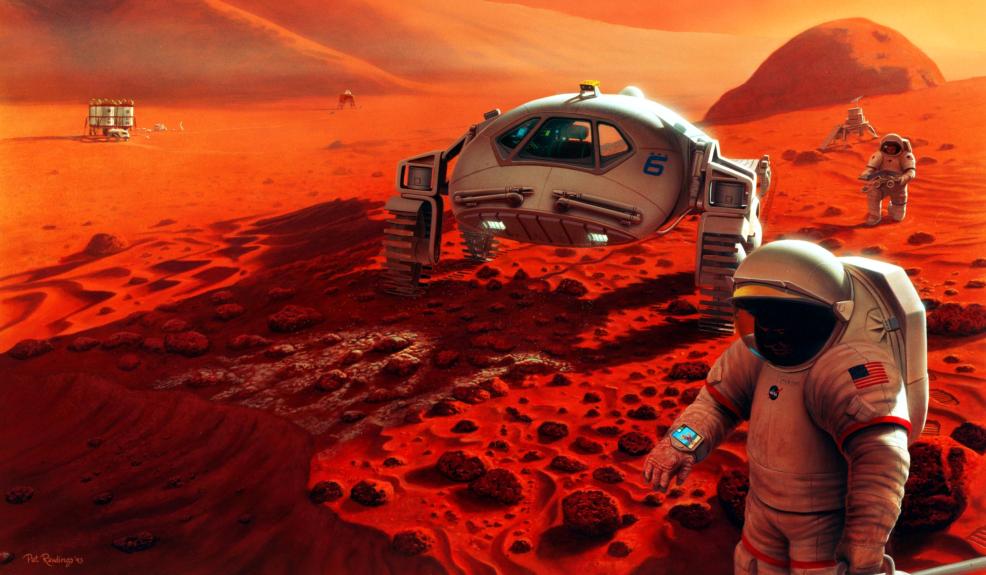
NASA got its first chance to analyze how space suits fared on the Moon only after the Apollo astronauts returned to Earth.
Future human explorers on Mars will have a different experience. The materials weaved in to their protective gear will have already been field tested by a robot.
The yet-to-be-named Mars 2020 rover, the followup to Curiosity, will carry a small payload of space suit materials with it, according to officials at NASA.
The samples will serve two roles. First, they’ll act as a calibration target for a laser instrument called SHERLOC (Scanning Habitable Environments with Raman and Luminescence for Organics and Chemicals). Second, the decay of those materials over time will provide unprecedented information about how to protect humans from specific Martian hazards, such as the chemicals in the soil, ultraviolet light and radiation.
“That will tell us how long an astronaut’s suit will last on Mars, long before any astronaut has to depend on their suit for their survival,” Marc Fries, a SHERLOC co-investigator and curator of extraterrestrial materials at the Johnson Space Center, said in an email.
The Mars 2020’s primary mission is to search for signs of microbial life and past habitable conditions on Mars.
Caltech’s Jet Propulsion Laboratory, the lead on the 2020 rover, invited its colleagues at the Johnson Space Center to send along materials such as Teflon and poly-carbonate, which are used to make the outer layers of a suit, its gloves and visor, according to NASA. In Houston, the space center will test the same types of materials in a Mars chamber and then calibrate the results based on SHERLOC’s analysis. Those results will also help fine-tune the chamber.
“We can then test any manner of materials and equipment in a calibrated Mars-like environment — bearings, motors, actuators, you name it,” Fries said in his email.
In earlier tests, NASA exposed current and future space suit materials to 2,500 hours of ultraviolet radiation equivalent to that on Mars. Most materials lost tensile strength and “became more brittle,” according to a study presented at the 47th International Conference on Environmental Systems last year. That’s based on a 500-day surface stay on Mars with 10 hours of “extra vehicular activity,” or EVA.
The Mars 2020 rover has an expected life of one Martian year, the equivalent of about 12,000 hours of UV exposure, the study states.
The real world testing will show whether other factors, such as low pressure, solar flux or dust blowing around, could result in changes to space suits, according to Rohit Bhartia, SHERLOC’s deputy principal investigator at JPL. The space suit materials will be positioned near the elbow joint of the rover’s arm and exposed constantly to the environment.
“It lays a foundation for future Mars exploration by humans,” Bhartia said. “It is a really good step in terms of people’s safety.”
The Mars 2020 mission is expected to move faster than Curiosity or its predecessors. Having calibration targets will allow NASA to ensure SHERLOC stays at the right alignments and sensitivity after being exposed to temperature changes and jostling from the launch and landing.
SHERLOC is the first instrument on Mars to use Raman and fluorescence spectroscopies, similar to the techniques used by forensics experts, according to NASA. One of 2020’s goals is to determine if life ever existed on Mars, and SHERLOC helps do that by creating a glow, similar to a blacklight, when it shines over chemicals that form in the presence of life.
The space suit materials are not the only sample going along for the trip. NASA is sending a chunk of a Martian meteorite, one of about 200 confirmed in the world, back to Mars to also act as a calibration target. Half of the sample will stay here on Earth.

“It basically allows us to do an experiment with a control that we brought with us,” Bhartia said.
It wasn’t easy to get however. NASA rejected the team’s request for a meteorite from its collection. The team ended up getting the piece they needed from the Natural History Museum of London. The piece, called Sayh al Uhaymir 008 (SaU008), was found in Oman in 1999, and is believed to have come from Mars millions of years ago. Gases trapped in the meteorites match those found in Mars atmosphere by the Viking mission in 1976. The pieces of Mars also show igneous processing not possible on asteroids, according to NASA.
It will be the first meteorite to return to Mars’ surface. The Mars Global Surveyor, a now-defunct mission, carried a chunk of meteorite in to orbit.
Mars 2020 is expected to launch in July or August of that year.

